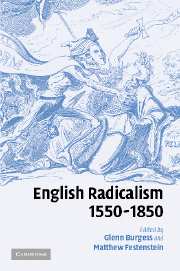Book contents
- Frontmatter
- Contents
- List of contributors
- Introduction
- Chapter 1 A politics of emergency in the reign of Elizabeth I
- Chapter 2 Richard Overton and radicalism: the new intertext of the civic ethos in mid seventeenth-century England
- Chapter 3 Radicalism and the English Revolution
- Chapter 4 ‘That kind of people’: late Stuart radicals and their manifestoes, a functional approach
- Chapter 5 The divine creature and the female citizen: manners, religion, and the two rights strategies in Mary Wollstonecraft's Vindications
- Chapter 6 On not inventing the English Revolution: the radical failure of the 1790s as linguistic non-performance
- Chapter 7 Disconcerting ideas: explaining popular radicalism and popular loyalism in the 1790s
- Chapter 8 Henry Hunt's Peep into a Prison: the radical discontinuities of imprisonment for debt
- Chapter 9 Jeremy Bentham's radicalism
- Chapter 10 Religion and the origins of radicalism in nineteenth-century Britain
- Chapter 11 Joseph Hume and the reformation of India, 1819–33
- AFTERWORDS
- Index
Chapter 1 - A politics of emergency in the reign of Elizabeth I
Published online by Cambridge University Press: 26 June 2009
- Frontmatter
- Contents
- List of contributors
- Introduction
- Chapter 1 A politics of emergency in the reign of Elizabeth I
- Chapter 2 Richard Overton and radicalism: the new intertext of the civic ethos in mid seventeenth-century England
- Chapter 3 Radicalism and the English Revolution
- Chapter 4 ‘That kind of people’: late Stuart radicals and their manifestoes, a functional approach
- Chapter 5 The divine creature and the female citizen: manners, religion, and the two rights strategies in Mary Wollstonecraft's Vindications
- Chapter 6 On not inventing the English Revolution: the radical failure of the 1790s as linguistic non-performance
- Chapter 7 Disconcerting ideas: explaining popular radicalism and popular loyalism in the 1790s
- Chapter 8 Henry Hunt's Peep into a Prison: the radical discontinuities of imprisonment for debt
- Chapter 9 Jeremy Bentham's radicalism
- Chapter 10 Religion and the origins of radicalism in nineteenth-century Britain
- Chapter 11 Joseph Hume and the reformation of India, 1819–33
- AFTERWORDS
- Index
Summary
In the third volume of his Political Disquisitions the Scottish philosopher James Burgh explored the historical dimensions of his call for the reformation of parliament. ‘Before all other things’, he wrote, ‘there must be established a grand national association for restoring the constitution’ as a statement of the established right of the English people to act in an extra-parliamentary way. Working primarily from the British histories of David Hume, Burgh rehearsed some of the radically defining moments in the historical relationship between monarch and subject, from the barons’ opposition to King John – ‘the first attempt toward an association for a plan of liberty, according to Mr Hume’ – to the proposal for a ‘grand national association against popery’ in 1680. For Burgh a purpose of these associations was the protection of protestantism; another was the safety of the crown. He recorded two other examples: a ‘general association all over England for the defence of Elizabeth’ in 1586, and ‘afterwards for that of William and Mary’.
James Burgh's account of these bonds between subject and monarch (or subject and subject) was naively simplistic, driven by a notion of historical progress and development which was deeply anachronistic. Popular action in the sixteenth century, in the sense that Burgh understood it, did not exist, because the social and political structures of the Tudor polity were radically different from those of the late eighteenth-century state.
- Type
- Chapter
- Information
- English Radicalism, 1550–1850 , pp. 17 - 36Publisher: Cambridge University PressPrint publication year: 2007
- 3
- Cited by

